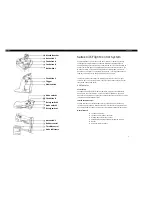
3
www.balmar.net / Customer Service: +1 (360) 435-6100 x1 / Technical Support: +1 (360) 435-6100 x3
Tech Service is available Monday - Friday (8:30am - 7:30pm EST)
LFP LiFeP0
4
Recommendations
Our LFP program is a generalized version of the recommendations provided by the top LFP battery manufacturers.
For best performance and compatibility, please consult your battery manufacturer and use the regulator’s advanced
programming features to adjust the LFP program as needed. LFP batteries are more sensitive to abuse than a
traditional chemistry battery and can fail catastrophically. It is HIGHLY recommended that the charging system as
a whole be installed or inspected by a qualified marine electrical installer that has experience with Balmar charging
system products and LFP batteries. The LFP profile is intended to work with the battery manufacturer’s battery
management systems (BMS). The LFP profile IS NOT a replacement for a BMS.
Many LiFePo4 batteries have a Battery Management System (BMS) that may disconnect the battery
from the alternator as a protective action or when charging is complete. The regulator must be shut down
before the battery is disconnected .Running an alternator without a battery will damage the alternator
and may damage any attached system. This is doubly true if the battery can be disconnected during
high current charging, causing a load dump. The load dump can easily cause a high voltage spike
which will destroy the alternator’s rectifier, at minimum. This is not a warrantable failure. To reiterate:
THE ALTERNATOR MUST BE SHUT DOWN BEFORE DISCONNECTING THE BATTERY. THE ONLY
SAFE WAY TO SHUT DOWN THE ALTERNATOR IS TO TURN OFF THE REGULATOR. The preferred
method of turning off the regulator is disconnecting the regulator’s ignition (brown) wire, but if used as
an EMERGENCY ONLY shutdown, disconnecting the regulator’s power input (red) wire in addition to the
ignition wire has a very low chance of damaging the regulator.
LFP batteries will readily accept a damaging amount of current. Applying too much charge current
to a LFP battery will, at the very least, permanently damage the battery’s capacity. It is CRITICAL to
ensure that the alternator is not capable of exceeding the maximum continuous charge current rating of
your battery (or batteries). As always, check with your battery manufacturer for specifics. Your battery
manufacturer may supply you with a “C-rate” for charging and discharging. The maximum amount of
charging current your battery can safely handle is determined by multiplying the “C-Rate” by the capacity
of the bank. i.e. 4x 100Ah 12V batteries rated at 0.5C charge = 400 Ah * 0.5C = 200amps MAX. If your
alternator is capable of outputting more current, at any time or condition, than the battery (or batteries)
can handle, you may use the Amp Manager feature on the MC-624 to lower the maximum field drive
output, and thereby lower the maximum alternator output current. See page 10 of your regulator
manual for details and instructions. Be aware that it is not an exact 1:1 correlation between field output
and alternator output, so start with more reduction (lower output) than you think you need and adjust
accordingly.
It is strongly recommended that an alternator temperature sensor (MC-TS-A) be used when charging LFP
batteries. Given the extremely high charge acceptance rate of LFP batteries, the alternator will be driven
to full output for almost all of the charge cycle. This can cause overheating in automotive style alternators
resulting in a significantly shortened lifespan. When equipped with the MC-TS-A temperature sensor,
the MC-624 will help you protect your investment by reducing the field voltage to your alternator by 50%
when over the “AL1” temperature threshold. If you cannot use an MC-TS-A in your application, you should
monitor the alternator’s temperature (measure as close to the loop ends of the stator as possible) and
discontinue charging if the alternator temperature rises above the maximum recommended level. You may
also use the Amp Manager feature on your MC-624 to reduce maximum output until a tolerable alternator
temperature is maintained under all conditions.
Most LFP battery manufacturers specify minimum and maximum charging temperatures to be from
freezing (32°F, 0°C) to around 111°F (44°C). Again, consult with your battery manufacturer for specifics.
When equipped with a MC-TS-B, the MC-624 can disable charging if the battery temperature exceeds
the “B1L” temperature threshold and re-enable charging when the temperature drops below the threshold.
This feature is meant to supplement, not replace, your BMS’s temperature protection features. “B1L”
should be adjusted to be slightly less than BMS’s temperature threshold. Note that the regulator does not
have the capability to prevent charging during low temperatures.




































